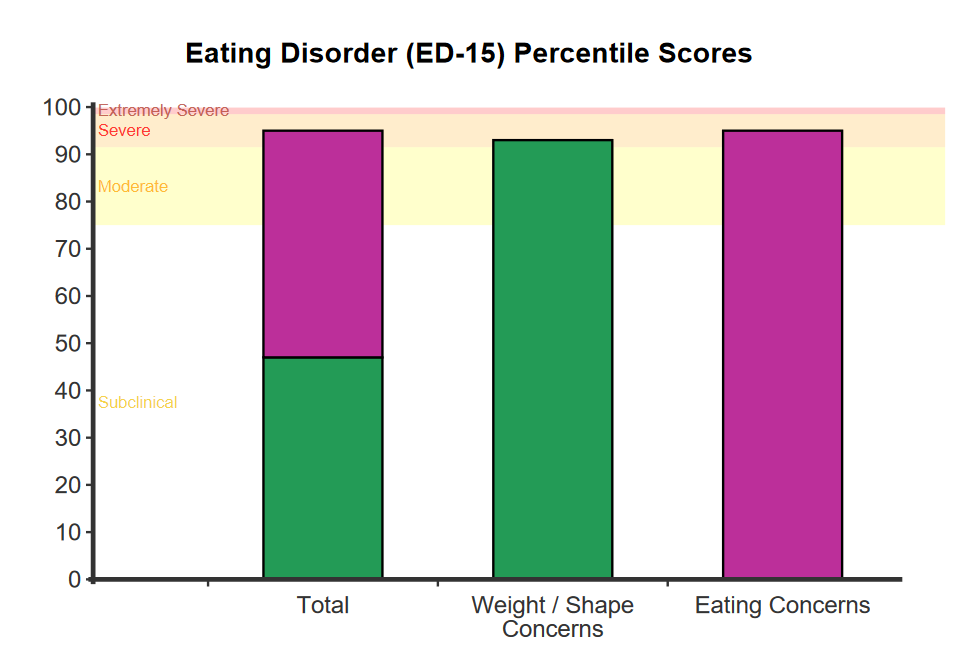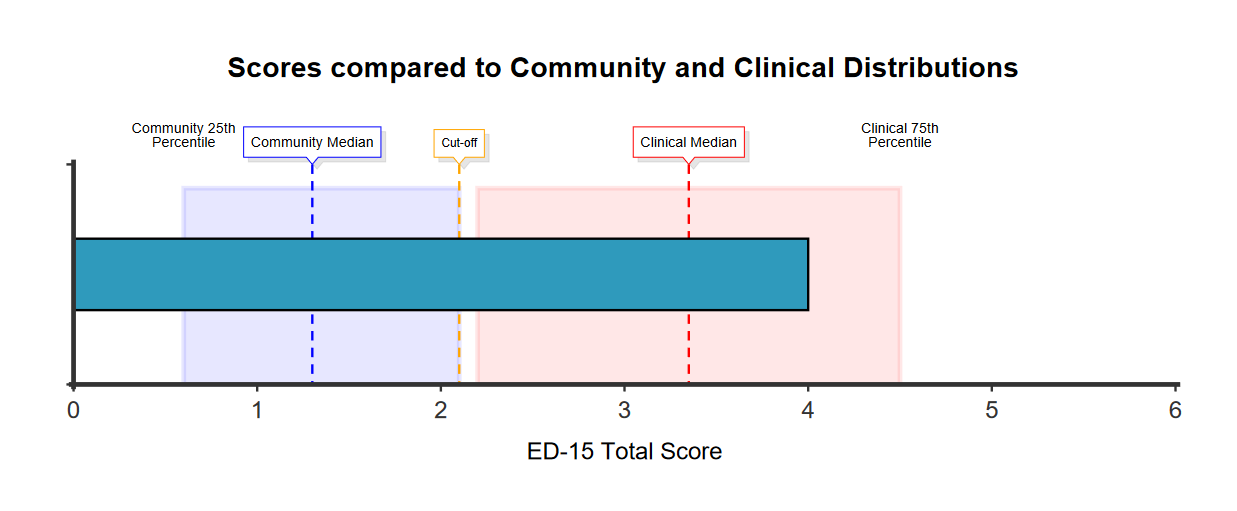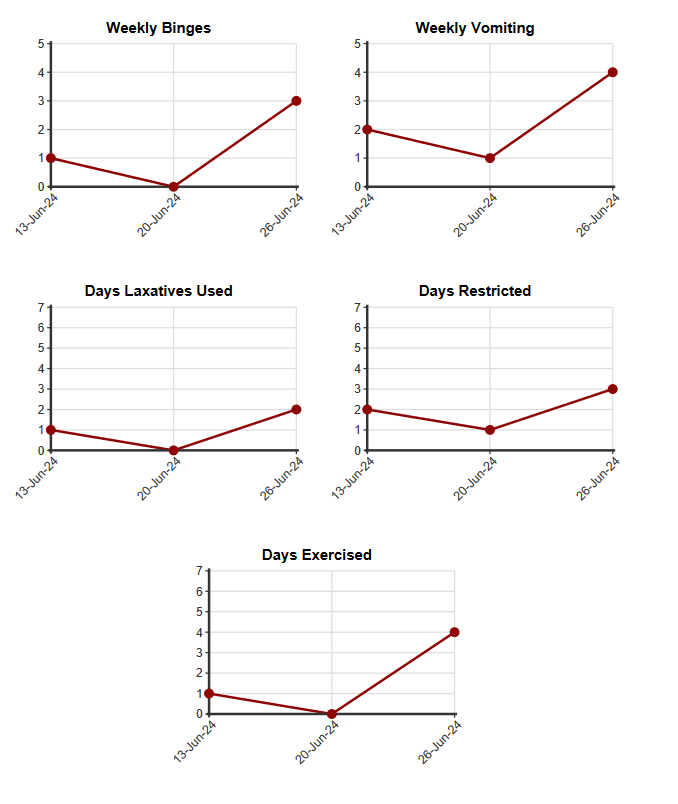The Eating Disorder-15 is a 15-item scale to measure session-by-session change for eating disorder attitudes and behaviours. The scale measures the frequency of eating-disordered behaviours and has two factors:
Example ED-15 items:


A comparison graph is presented showing the typical pattern distributions of responses for the community and clinical sample, with areas around the median defining the range between the 25th and 75th percentiles. Scores of 2.1 or above are considered to be clinically significant and indicate a likely eating disorder with a sensitivity of .73 and specificity of =.73.
 Subscales are presented:
Subscales are presented:
If administered more than once the change in scores will be evaluated against the the Reliable Change Index (RCI; Rodrigues et al., 2019)), which defines clinically meaningful change in scores as a total score of 1 or more.
 The behavioural items (items 11 to 15) are represented by the frequency they have occurred in the past week.
The behavioural items (items 11 to 15) are represented by the frequency they have occurred in the past week.

When compared to longer scales such as the EDE-Q there is a very high correlation (r = .889) indicating that the ED-15 and EDE-Q measure near-identical constructs (Tatham et al., 2015). The ED-15 differentiated self-reported eating-disordered and non-clinical groups to the same degree as the longer EDE-Q.
Factor analysis identified two scales (Weight & Shape Concerns; Eating Concerns), with strong internal consistency and test-retest reliability (Tatham et al., 2015). The split-half reliability of the scale as a whole was satisfactory (Spearman-Brown coefficient = .926). The same was true for the Weight & Shape Concerns (0.926) and the Eating Concerns scales (.704). For test-retest reliability, the mean gap between completions was 18 days (range = 14-22) and correlations ranged from .860 to .908.
When tested on 33 formally diagnosed eating-disordered women, the ED-15 scores changed across ten sessions of CBT therapy, however, the two scores changed at different time points (Tatham et al., 2015). The Eating Concerns score showed its greatest change between sessions 1-4 and then from sessions 8-10, while the Weight & Shape Concerns score changed most at a later point in the therapy (between sessions 3-6, and then again from sessions 8-10). This difference in patterns of change indicates the distinctive clinical utility of each ED-15 scale.
The ED-15 total score has a good discriminant power with a patient randomly selected having an 80% probability of being correctly classified based on a higher global score than a non-case (Rodrigues et al., 2019). In a Portuguese sample (Rodrigues et al., 2019) an ED-15 total score cutoff of 2.1 was selected. This cut point maximises the value of sensitivity (Se=.73) and specificity (Sp=.73). The median total score from this sample was 1.30 (50th percentile) and the cut point of 2.1 corresponds to a percentile of 75.
The percentiles are based on the means and standard deviations derived from a study by Rodriguez et al (2019). The clinical sample consisted of 265 women aged 13-60 years old (mean age = 27.19, SD = 10.32) seeking treatment for eating disorders. Participants met the DSM-5 criteria for anorexia nervosa (47.9%), bulimia nervosa (26.4%), binge eating disorder (9.4%), or other specified feeding or eating disorder (16.2%). Additionally, the non-clinical sample consisted of 860 females aged 15-52 (mean age = 21.51; SD = 3.92 (Rodrigues et al., 2019).
According to a study by Rodrigues et al. (2019), an RCI of 0.97 denotes a significant improvement or deterioration in ED-15 total scores. Considering that the smallest possible score interval for the total score is 0.1, NovoPsych adopts an RCI threshold of 1 to represent meaningful improvement or deterioration.
ED-15 Attitudinal scales
ED-15 Behavioral items
The study involves a large sample from both clinical and non-clinical backgrounds, giving a broad perspective. It also includes individuals with various types of eating disorders, making the findings relevant broadly across eating disorders (Rodrigues et al., 2019).
Using the community and clinical samples, NovoPsych defined three symptom severity levels for the total score.
Tatham, M., Turner, H., Mountford, V. A., Tritt, A., Dyas, R., & Waller, G. (2015). Development, psychometric properties and preliminary clinical validation of a brief, session-by-session measure of eating disorder cognitions and behaviors: The ED-15. The International Journal of Eating Disorders, 48(7), 1005–1015. https://doi.org/10.1002/eat.22430
University of Sheffield resources for cognitive behavioural therapy in ten sessions for patients with non-underweight eating disorders. https://cbt-t.sites.sheffield.ac.uk/resources
Accurso, E. C., & Waller, G. (2021). A brief session-by-session measure of eating disorder psychopathology for children and adolescents: Development and psychometric properties of the Eating Disorder-15 for Youth (ED-15-Y). The International journal of eating disorders, 54(4), 569–577. https://doi.org/10.1002/eat.23449
NovoPsych’s mission is to help mental health services use psychometric science to improve client outcomes.
© 2023 Copyright – NovoPsych – All rights reserved